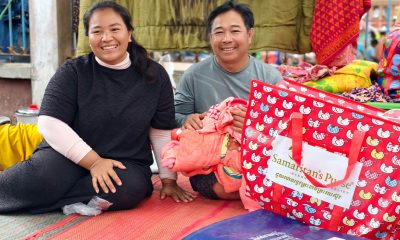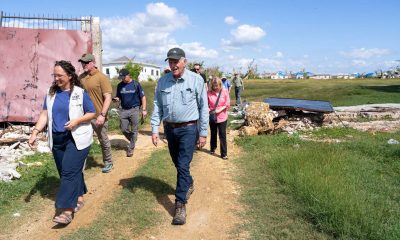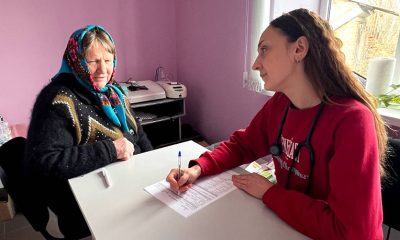A volunteer in the Philippines writes about the tasks she accomplished and the people she met while working with Samaritan's Purse.
Joann Nelson and her husband, Jay, love to travel. They booked a trip to the Philippines before Typhoon Haiyan struck. They wanted to help people while on their trip, so they got involved with Samaritan’s Purse.
We booked our flight into Cebu, Philippines, on October 27. On November 8, the typhoon hit. We could hardly believe what we saw and heard on the news. It was a devastating storm, the most destructive in recent history. It’s hard to grasp the pain and suffering it caused for millions of people.
 In the wake of this terrible storm, we questioned whether we should still go to the Philippines; we still wanted to but only if it was appropriate.
In the wake of this terrible storm, we questioned whether we should still go to the Philippines; we still wanted to but only if it was appropriate.
In the next few days, we learned more about what areas were damaged and which were OK and found that there were still many places we could go. We also learned that the tourism board was urging people to visit the country, stressing that tourists visits will have a direct effect on helping to rebuild lives and keep locals in jobs. We resolved that we would still go.

These are some of the 100 tons of supplies that arrived on the first cargo jet in the Philippines. Since then, we have sent a second cargo jet with plastic sheeting, a helicopter, and Christian literature and a third jet full of Operation Christmas Child shoeboxes.
Our good friend Abby, who is on staff with Samaritan’s Purse in Nigeria, got us in touch with the Samaritan’s Purse folks in the Philippines. Things fell together just in time for us to spend our first week in the Philippines volunteering with Samaritan’s Purse in Cebu. The city of Cebu sits between several of the hardest hit areas, but it didn’t experience damage from the typhoon.
Samaritan’s Purse set up an office and warehouse in the city as a base for relief operations in the region. We spent most of our time at the warehouse helping take inventory and pack pallets of supplies to be shipped to areas in need.
The first task we were given was to take inventory of all the supplies. The supplies were primarily for hygiene kits (bars of soap, detergent sachets, toilet paper, etc.) and shelter kits (containing tools and materials to build shelters for four families). The concept of the shelter kits is that one kit is given to a group of four families who share the tools and supplies and help each other build.
One of the main tasks at the warehouse when we were there was packing nails for the shelter kits. There were many people from the community that helped.
On Monday afternoon, a woman named Lollette came to the warehouse with a group of young adults to help pack nails. We worked at the same table and got to know her. She explained that the group was from a program she started to provide mentoring and training to youth who have finished high school but have not gone to college.
Many of the youth have troubled backgrounds. Through the program, they learn how to develop valuable life skills and are taught foundational principles such as communication, leadership, and time management to set them up for success in life. The youth also receive an opportunity to work and earn money while developing business skills. After successfully completing six months, they are given a scholarship to attend college. (A college education is critical to obtaining gainful employment in the Philippines.)
A Precious Shipment and Bright Smiles

We have distributed 56,000 water purification tablets and 164 household water filters in the Philippines since Typhoon Haiyan. Andrew Conard, who works as our water, sanitation, and hygiene specialists during the first weeks after the storm, tested water to determine whether it was safe to drink.
During the week, we also helped load trucks as they arrived to carry off the goods. One of the areas hardest hit by the typhoon was Tacloban. Flights into the airport there were very limited, so goods were loaded onto large trucks in the Cebu warehouse and made their way to Tacloban via ferry.
In my opinion, the most precious shipment that came into the warehouse was the thousands of Operation Christmas Child boxes that arrived from the U.S. and Canada. A special shipment of 65,000 shoeboxes was sent to the Philippines. Each shoebox is filled with Christmas gifts for a child, packed specifically for a boy or girl of a certain age. The shoeboxes will bring smiles to the faces of thousands of Philippine children. I also hope that they bring many children comfort and encouragement along with an understanding that they are loved and not forsaken.
Our last day in Cebu, I had the opportunity to help out in the Samaritan’s Purse office, actually utilizing some of my Human Resources skills. As you can imagine, there is a lot of paperwork and documentation that goes into running an effective relief operation. It was a nice change of pace from the warehouse and was certainly better suited toward my skill set.
Language is a bit complicated in the Philippines. There are more than 100 different languages spoken across the country. The official language is Filipino, which is essentially Tagalog plus common words derived from English and Spanish. Cebuano is the official language of Cebu, but we found English to be everywhere and spoken by nearly everyone we encountered. As a result, communicating was easy. The only native word I really used was “salamat,” which means thank you. Although an English thank you would certainly do, “salamat” always seemed to bring a bigger smile to the faces I said it to—and I found the people here to have brightest smiles, despite the hardships they have endured.






